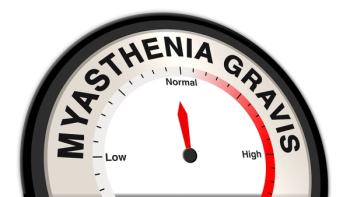
Small Device Improves Breathlessness in Patients With COPD
The device, PEP Buddy improves breathlessness symptoms and quality of life in patients with chronic obstructive pulmonary disease (COPD), as well as people who have anxiety and stress.
Researchers at the University of Cincinnati (UC) College of Medicine have created a hands-free, oral positive expiratory pressure (PEP) necklace, called PEP Buddy, that improved breathlessness symptoms and quality of life (QOL) among individuals with
“Dr. Panos [Ralph Panos, MD, professor emeritus in pulmonary and critical care at the UC College of Medicine and director of the national tele-ICU program for the US Department of Veterans Affairs] and I both see patients with COPD, and it’s a huge population,” said Muhammad Ahsan Zafar, MD, associate professor in the Department of Pulmonary Critical Care and Sleep Medicine at the UC College of Medicine,
The results of thispilot study were
People with COPD take longer to get air in and out of their lungs, which causes air to be retained in the lungs during exercise. This air stacking is called “dynamic hyperinflation,” and is the main reason for breathlessness and lower oxygen levels. Ultimately, this can lead to people with COPD becoming less active or motivated, resulting in isolation and a lower QOL.
The researchers included 32 individuals with COPD with forced expiratory volume per 1 second (FEV1) less than 80% predicted and signs of exertional dyspnea or exertional desaturation during a 6-min walk test.
The study found that 23 (72%) participants had improved shortness of breath (FEV1, 40.4% vs 56.5%; P = .009) and forced vital capacity (68.5% vs 82.0%; P = .03) when using PEP Buddy compared with participants who did not experience exertional dyspnea. Furthermore, among 14 participant who had lower oxygen levels, only 5 (36%) experienced exertional desaturation with the use of PEP Buddy.
The researchers acknowledge some limitations to this study, including a small population size, only including individuals with moderate to severe COPD, and failure to explain the exact mechanism of action of PEP Buddy on exertional dyspnea and exertional desaturation.
Despite these limitations, the researchers believe PEP Buddy was able to improve breathlessness symptoms among individuals with COPD, which can lead to an improved life.
Additionally, the researchers believe that further studies should address this exact mechanism of action in addition to determining clinical factors that might predict a better response and the long-term impact of the disease on an individual’s QOL.
“PEP Buddy can be used as an add-on therapy to COPD medications and pulmonary rehabilitation to attenuate breathlessness and desaturation and improve QOL for individuals with COPD,” concluded the researchers. “It is perhaps the first noninvasive, portable, mechanical device that mitigates exertional desaturation.”
References
1. University of Cincinnati researchers develop innovative breathing aid. News release. EurekAlert! March 10, 2023. Accessed March 13, 2023. https://www.eurekalert.org/news-releases/982373
2. Zafar MA, Cattran A, Baker R, Jandarov R, Panos RJ. A hands-free, oral positive expiratory pressure device for exertional dyspnea and desaturation in COPD. Respiratory Care. 2022;68(3):408-412. doi:10.4187/respcare.10278
Newsletter
Stay ahead of policy, cost, and value—subscribe to AJMC for expert insights at the intersection of clinical care and health economics.













































